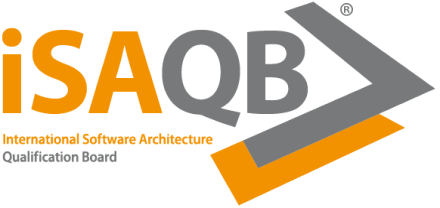How we can define software architecture?
We can define software architecture as the high-level structure and design of a software system, that encompasses crucial aspects like patterns, models, and tools used to shape and assess the architecture.
Whether you're a seasoned professional or a beginner, this page offers a wealth of information to delve into the realm of software architecture.
Creating software architecture involves identifying system requirements and making strategic choices about its organization, components, modules, relationships, and guiding principles.

So, what exactly is software architecture?
In essence, it provides a conceptual framework that guides the design, development, and maintenance of intricate applications. It aids in selecting suitable design patterns, orchestrating component interactions, distributing tasks, and ensuring effective communication.
Before embarking on long-lasting decisions, understanding user and stakeholder needs is pivotal. Effective architecture not only caters to these needs but also facilitates future scalability and maintenance.
Whether you're well-versed in the subject or just beginning your journey, explore the depths of software architecture on this page to gain invaluable insights.
Let's deep dive into software architecture and learn the details.
1- What are the characteristics of software architecture?
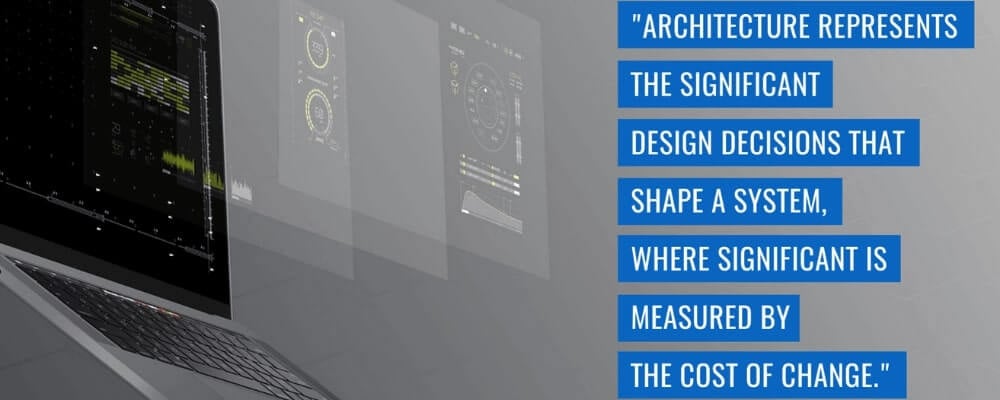
"Architecture embodies the crucial design decisions that shape a system, where the importance is measured by how much it costs to make changes."
This idea highlights that architecture involves making choices that require significant resources and time commitment. Take careful consideration of these decisions early on to ensure the architecture's practicality, ability to last, and cost-effectiveness in the long term.
Moreover, it emphasizes the need for architects to plan meticulously before carrying out decisions. Before implementing choices that will have long-lasting effects on the project, they should thoroughly understand the needs of users and stakeholders.
Ensure a design that works for everyone by exploring all options. This approach can prevent expensive fixes and modifications later on, ensuring the successful completion of the project. To assist in this planning, architecture planning software can be invaluable.
Creating software architecture
Creating advanced software architecture is a crucial phase in software development. A robust architecture aligns with customer needs, ensuring system ease of maintenance and scalability over time.
Here's a guide to the steps involved in crafting advanced software architecture:
- Understand Customer Requirements: Begin by comprehending customer requirements, encompassing both functional and non-functional aspects, to identify system components.
- Identify Building Blocks: Based on requirements, pinpoint the foundational elements of the system – databases, servers, clients, etc.
- Define Component Interactions: Map out how these identified parts communicate with each other effectively.
- Select Architectural Patterns: Choose suitable architectural patterns that fit the building blocks and system implementation needs.
- Prototype Testing: Validate the architecture by developing prototypes that help test and validate system functionality.
- Regular Design Checks: Continuously assess the design's viability to accommodate changes and additions.
Crafting advanced software architecture entails understanding needs, selecting appropriate components, and implementing the right design. Through a well-structured architecture, the software can be effectively maintained and extended in the long run.
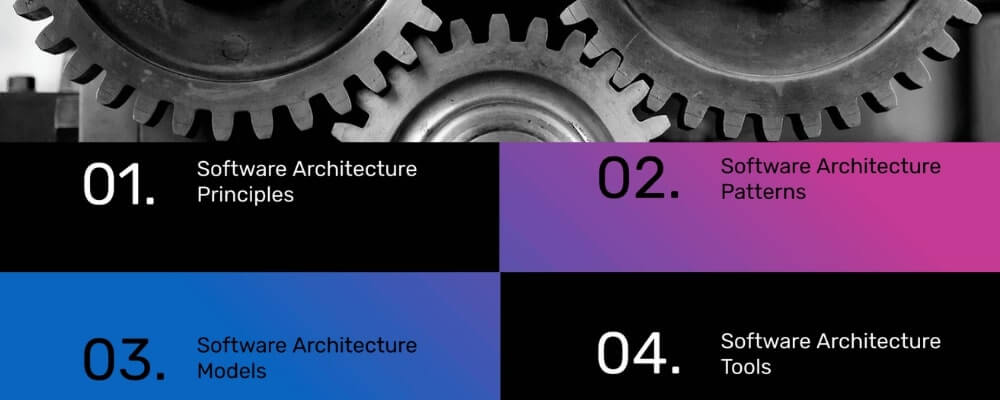
Software architecture principles
Software architecture principles are fundamental rules and guidelines to consider when developing and implementing software architectures. They include aspects such as modularity, scalability, reusability, and security, and contribute to developing an effective and robust software architecture. It is generally advisable to guide software architecture not with rigid rules, but rather with principles. These principles serve as a framework and guidelines for the development of the software structure.
Implementation is done by the development team, which leads to a strong identification with the architecture. Software developers and architects should work closely with the architecture to find the most suitable option.
Team decisions should reflect shared values and rules, even if democracy isn't always possible. This increases the acceptance of the architecture within the team.
Robert C. Martin's SOLID principles are a helpful foundation for software architecture and are the basis for many other principles.
- Single Responsibility Principle: Each part should do only one job and cover all of that job's functions. This is called the Single Responsibility Principle. When making changes to the software, there should always be a reason for it. In practice, a component has the right size when changes due to a user story only affect one component.
- Open-Closed Principle: The Open-Closed Principle can be applied on both small and large scales. Extensions to classes should be achieved not by modifying the class itself but through inheritance or, better yet, delegation. For larger software units, a plugin concept is useful, allowing additional classes to be added to extend functionality.
- Liskov Substitution Principle: A derived class must be replaceable for its base class in any context. It should only enhance the behavior of the base class without limiting it. The developer should not experience any surprises when using either the base class or a derived class.
- Interface Segregation Principle: The scope of an interface is determined by the client's requirements, not the other way around. A client should not be forced to implement functionality that it does not need. This strengthens the cohesion of modules while reducing coupling.
- Dependency Inversion Principle: In a layered architecture, classes, and modules exist at different levels of abstraction. Lower-level classes encapsulate implementation details, such as database connections, while higher-level layers deal with abstract business logic.
Higher-level modules should not depend on lower-level modules, but instead use interfaces. This is called the Dependency Inversion Principle. Interfaces, on the other hand, should not depend on details; rather, the details should depend on the respective interfaces.
Software architecture patterns
Software Architecture Patterns help improve software quality and maintenance by providing proven solutions for common design problems. They represent established practices and models tailored to specific problems and requirements, thus saving time and resources.
Software Architecture Patterns are typically documented and proven solutions to design problems that have been encountered in the past. They are a collection of knowledge and experience gathered by architects and developers over many years.
Software Architecture Patterns can enhance software quality and maintenance by offering a clear structure and hierarchy, while also reducing complexity. They can also facilitate collaboration within a team by establishing common patterns and principles.
Software architecture models
Various software architecture patterns exist, such as Layered Architecture, MVC (Model-View-Controller), Pipes and Filters, or Microservices. You should consider each pattern's pros and cons based on the context and requirements.
The following are some of the well-known models:
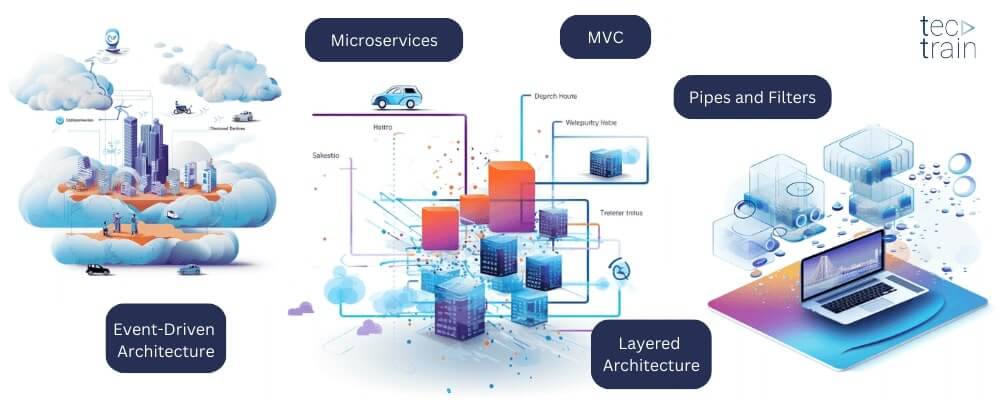
- Layered Architecture: In Layered Architecture, the system is divided into different layers, each serving specific functions and tasks. The layers are built hierarchically, with each layer communicating only with the immediately adjacent layer.
- MVC (Model-View-Controller): The MVC model divides the system into three components: Model, View, and Controller. The Model contains the data, the View defines the appearance, and the Controller controls the interaction between the Model and View.
- Pipes and Filters: This mode divides the system into a sequence of filters that handle and transmit data streams. The filters are connected in a pipeline, with data flowing through the pipeline and being processed by each filter accordingly.
- Microservices: In Microservices, the system is divided into smaller, independent services, each serving specific functions. Each service is self-contained and can be developed and deployed independently of the other services.
- Event-Driven Architecture: In Event-Driven Architecture, events, and state changes are considered a central part of the system. The system responds to events and can perform corresponding actions.
Each of these models has its advantages and disadvantages and is suitable for specific use cases and systems. Selecting the appropriate model for a given project is important to develop an effective and robust software architecture.
Featured Resource
Top 10 Software Architecture & Design Patterns of 2023
Software architecture design
"Every new situation demands a new architecture." - Jean Nouvel
Software architecture design is the process of planning and designing a software architecture. It involves deciding how to structure and organize the system's components and defining their relationships and interactions.
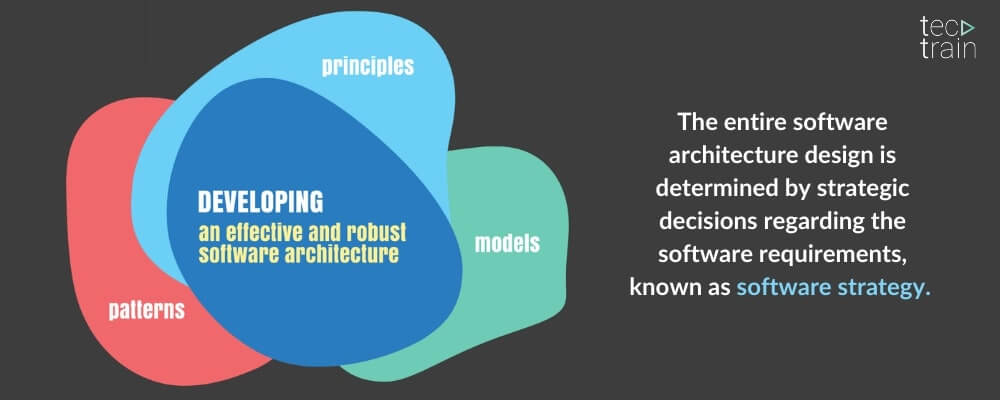
While developing an effective and robust software architecture, you take into account different
- Architectural patterns
- Models
- Principles
Designing software architecture is vital in software development as it lays the groundwork for implementing and bringing the system to life. Software architecture encompasses more than just the structure of the system, as other factors can also contribute to architectural failure. It includes all the important and hard-to-change decisions related to the architecture.
Achieving successful software architecture involves employing various approaches, including considering quality scenarios and utilizing the expertise of the entire team.
The entire software architecture design is determined by strategic decisions regarding the software requirements, known as software strategy. A well-planned system design is crucial because modifying design artifacts in the software architecture can often be difficult and expensive.
Scalability is an important aspect of software architecture. It involves expecting future scenarios and designing the system to handle increasing demands. There are some key properties of scalability, such as core system functionality, performance, and security. You have to be sure that the software can adapt and effectively meet user needs as requirements evolve.
When making software architecture decisions, you must take into account the requirements and business goals. It is important not to make decisions without a good reason. There are widely available means of representing architectures and various tools that improve clarity.
One such tool is the quality tree, defined in ISO 25010 and included in standards like arc42. A quality tree is a helpful tool that lists various quality characteristics, including security and reliability.
It also provides sub-characteristics for each category. Using a quality tree simplifies the process of thoroughly examining software.
Software architecture tools
Various tools and frameworks can assist in the creation and review of software architectures. Here are some of the well-known tools and their features:
- Archi: Archi is an open-source tool that aids in creating architecture diagrams. It provides a simple user interface and can support various architectural patterns like TOGAF, ArchiMate, and Zachman Framework.
- Visual Paradigm: Visual Paradigm is a tool that supports the modeling of software architectures. It offers various diagram types, including use case diagrams, sequence diagrams, and class diagrams.
- Enterprise Architect: Enterprise Architect is a tool that supports various architectural patterns, including TOGAF, Zachman, and BPMN. It provides a wide range of diagram types that can assist in modeling systems.
- C4 Model: The C4 Model is a method for documenting software architectures. It provides a simple way to layered structure an architecture and defines various components.
- Lucidchart: Lucidchart is an online tool that assists in creating architecture diagrams. It offers a variety of templates and a user-friendly interface.
With various features and capabilities, these tools differ from one another. Therefore, it is crucial to select the tool that best aligns with your specific needs and preferences.
2- What are the 3 types of software architecture?
The three types of software architecture are:
- Monolithic Architecture: In this architecture, the entire software application is built as a single, self-contained unit. All components and functionalities are tightly integrated, making it challenging to scale or modify specific parts freely.
- Client-Server Architecture: This architecture involves dividing the software application into two major components: the client and the server. The client, typically a user interface, interacts with the server, which manages the business logic and data storage. This allows for better scalability and distribution of responsibilities.
- Microservices Architecture: Microservices architecture decomposes the software application into a collection of small, independent services. This approach promotes modularity, scalability, and flexibility.
These three types of software architecture have different approaches to design and organization. Each has its advantages and trade-offs.
3- What is the difference between software engineering and software architecture?
Software engineering and architecture in software engineering (software architecture) are intertwined yet distinct aspects within the software development realm.

Software engineering encompasses the entirety of software system development, encompassing coding, testing, and maintenance. In contrast, architecture in software engineering is a specialized facet, emphasizing the system's high-level design and structure. Software architects formulate design decisions that software engineers execute, adhering to engineering principles and practices.
Featured Resource
Software Architecture vs. Design: A Comprehensive Guide
4- What does a software architect do?
A software architect analyzes the requirements for a system. They select technologies and create a blueprint for the architecture of software development. Their role involves designing and planning the software architecture, collaborating with the team, fostering individual growth, and considering diverse interests – akin to urban planning for complex enterprise information systems.
The role of a software architect transcends mere title or position. It's defined by the art and practice of architecture within the context of software development.
Featured Resource
What Does A Software Architect Do?
5- How to become a software architect?
The role of a software architect is vital today, considering the crucial role software applications play across various industries and domains. The demand for well-designed and reliable software applications has significantly increased with digital transformation. However, there is still a shortage of qualified and experienced software architects capable of designing and implementing complex systems.

Becoming a software architect is a significant and promising career path that holds high demand and significance. To become a software architect, there are various paths and requirements you can acquire or pursue. Here are some examples:
- Education and Degree: A completed degree or education in computer science is essential for a career as a software architect. You need, a Bachelor's or Master's degree in computer science, software engineering, or a related field.
- Practical Experience: To work as a software architect, it is important to have practical experience in software development. Several years of professional experience in software development and implementing complex projects can help kickstart a career as a software architect.
- Continuing Education and Certifications: Various educational opportunities and certifications exist in software architecture. They provide the knowledge and skills needed to work as a software architect. Prominent certifications include TOGAF or Certified Software Architect.
- Technical Understanding: A solid technical understanding is also important for working as a software architect. This includes knowledge of various programming languages, databases, software development processes, and methodologies, as well as different architecture patterns and models.
- Soft Skills: In addition to technical skills, soft skills such as communication, teamwork, and problem-solving abilities are crucial
Featured Resource
How to Become A Software Architect?
6- What requirements does a software architect need?
A software architect typically needs a combination of education, experience, and skills. Key knowledge for a software architect includes:
- Education: You must have a bachelor's or master's degree in computer science or a related field. For senior roles, you may need higher education.
- Experience: Extensive experience in software development is essential. Candidates should have several years of hands-on experience as software engineers or developers, working on complex projects.
- Technical Skills: Strong proficiency in multiple programming languages, software development frameworks, and tools are necessary. Cognition of architectural patterns, design principles, and system integration is valuable.
- Architectural Knowledge: In-depth understanding of software architecture concepts, styles, and best practices is vital. Knowledge of frameworks like TOGAF can be advantageous.
- Communication and Leadership Skills: Effective communication is crucial for interacting with stakeholders. Collaboration skills are essential for working with teams. Leadership abilities are necessary for guiding teams and presenting architectural solutions.
- Problem-Solving and Analytical Skills: You must have strong problem-solving skills to analyze requirements. Analytical skills are necessary to identify challenges. You need those skills to propose appropriate solutions.
- Continuous Learning: A passion for ongoing learning is crucial. Staying updated with emerging technologies and trends is essential. It enables adaptation to evolving architectural practices.

Formal requirements and certifications can enhance a software architect's profile. On the other hand, there are some more requirements for success in this role;
- Practical experience
- Technical expertise
- A deep understanding of software architecture concepts
Featured Resource
What Qualifications Does A Software Architect Need?
7- How to improve your software architecture skills?
You can improve software architecture skills through;
- Self-study,
- Practical experience,
- Learning from field experts

Books and online courses can help enhance your software architecture skills.
Remember that improving software architecture skills requires a combination of theory and practical application. Applying learned concepts and principles to real-world projects is crucial. It provides hands-on experience and helps hone architectural abilities.
Featured Resource
5 Recommendations for Exciting Software Architecture Books
8- Why Is Software Architecture Certification Important?
Software Architecture Certification holds immense significance due to its validation of your competence in designing efficient and effective software systems. By obtaining this certification, you present employers and clients with evidence of your capability to tackle intricate architectural challenges. This certification also sets you apart in the competitive job market, unlocking doors to superior career prospects and potentially increased earnings.
This certification acts as a symbol of credibility, instilling confidence in your capabilities and positioning you as a reliable choice for critical projects. In essence, Software Architecture Certification serves as a testament to your skills, vouching for your proficiency and making you a dependable asset to any team.
Let's delve into a few concrete examples that underscore the pivotal importance of software architecture certification:
- Credibility and Trust
- Career Advancement
- Competitive Edge
- Complex Projects
- Global Recognition
- Quality Assurance
- Networking Opportunities
- Professional Development
- Skill Validation
- Personal Satisfaction
Software Architecture Certification offers a multidimensional boost to your career. It enhances your credibility, empowers your skills, and positions you as a pivotal contributor in the dynamic field of software architecture.
By obtaining iSAQB certifications, software architects can demonstrate their proficiency in various aspects of software architecture, validating their knowledge and expertise. The iSAQB certifications are recognized internationally and can be beneficial for career advancement and professional growth.
In summary, iSAQB offers a certification program aiming to standardize and validate their knowledge and competencies in the field. The certifications provide recognition and credibility in the field and can enhance career opportunities for software architects.
Featured Resource
Software Architecture Certification Guide: Becoming Certified
TOGAF vs iSAQB: A Detailed Comparison
9– Summary
In conclusion, understanding what is software architecture is pivotal for crafting resilient, scalable, and high-performing software systems. Acquiring certificates in software architecture elevates individuals' expertise, competence, and worth, while also securing industry acknowledgment and trust.
Investing in and defining software architecture, along with gaining pertinent certifications, significantly enhances project outcomes. This endeavor further propels careers within the ever-evolving landscape of software development.







